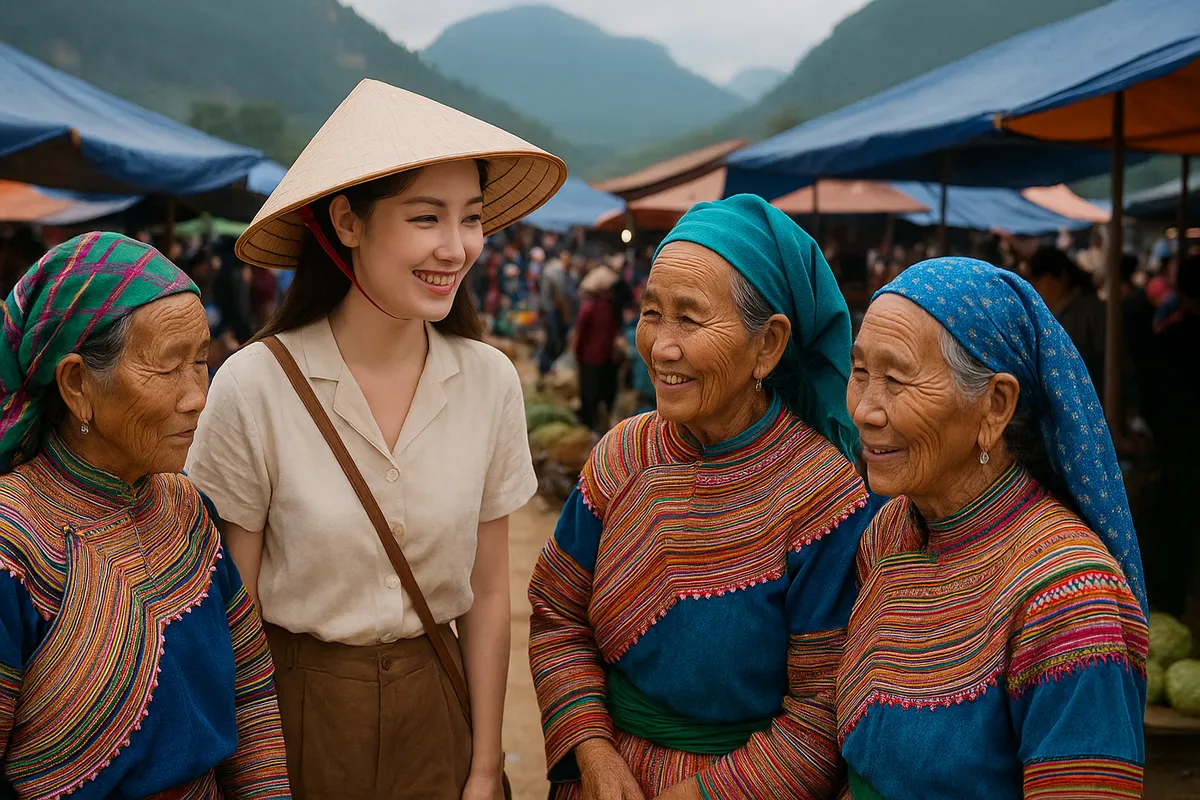How to integrate into local culture without feeling lost
- Sunday, Jun 01, 2025, 13:16 (GMT+7)
How to integrate into local culture without feeling lost
Arriving in a new land often brings a mixture of excitement and uncertainty. The desire to explore is accompanied by a quiet fear of standing out, of not belonging. But cultural immersion is not a rigid checklist of customs or a polite nod at a traditional greeting. It is a journey of understanding, a delicate dance of observation and open-heartedness, allowing you to become part of the cultural tapestry of the place you visit.
The process begins with the smallest things, like eye contact and a smile. In many ethnic communities in northern Vietnam, locals tend to observe newcomers silently before offering a warm welcome. An unintentional stare or avoiding eye contact altogether can cause discomfort. A gentle smile and a subtle nod often serve as the safest and most respectful greetings. Avoid diving into conversations or pulling out your phone for photos too soon. Cultural boundaries can sometimes be crossed simply by approaching too quickly.
Understanding a language is not just about spoken words. It also involves reading body language. In Hue, the gentle, slow pace of conversation may come across as distant, but it reflects grace and courtesy. In contrast, people in the Central Highlands might ask blunt questions like “Have you eaten?” or “Where are you going?” as a sign of friendliness. Interpreting the right tone and manner helps avoid miscommunication and feelings of being judged.
Clothing is another important but often overlooked aspect of cultural integration. It’s not about dressing exactly like the locals, but rather showing respect through appropriate choices. When visiting Muslim communities like those in Ninh Thuan, women should dress modestly, avoiding short skirts or revealing tops. When visiting temples or pagodas, long-sleeved shirts and long pants should be part of your travel essentials. In some places, removing shoes or avoiding contact with sacred objects is an unspoken rule, and simply observing locals closely will offer guidance.
You don’t need to be fluent in the local language, but learning a few simple phrases like thank you, hello, or delicious can go a long way. In Ta Van village, travelers who can speak even a few H’Mong words are often welcomed with more warmth. It’s not just about vocabulary, but about showing a willingness to understand and respect the local way of life. In remote areas like Con Co island or villages near the border, attitude and demeanor matter even more than spoken language.
In conversation, avoid judging or expressing overly strong reactions to cultural differences. In some parts of the Northwest, eating raw meat, drinking corn wine, or playing traditional instruments during funerals are common practices. Showing visible shock or rejecting an offer without sensitivity can be considered offensive. A helpful tip is to use neutral phrases like “That’s interesting” or “It’s my first time hearing this” instead of saying “That’s strange” or “That’s weird.” Even when you choose not to participate, a respectful gaze and smile can convey sincerity.
Meals are often where cultural misunderstandings happen most. In many Vietnamese households, especially in rural areas, sharing a drink is a crucial social ritual. No one will force you to drink beyond your limits, but refusing in an awkward or dismissive way may create distance. If you can’t drink, politely say so with a smile and heartfelt thanks. Never fake a toast only to secretly throw it away. That act is often perceived as deceptive and disrespectful.
An overlooked but powerful way to blend in is to slow down and observe. Spend the first few minutes in a new location just watching and listening. Let the rhythm of the place reveal itself. Locals will also be more likely to accept you as someone who truly wants to connect. In one trip to Ha Giang, instead of snapping photos, a group of travelers chose to help locals pick wild vegetables. That simple gesture became the most memorable part of their journey, far beyond what any itinerary could offer.
Attentive listening is another quiet but impactful skill. Letting locals tell their stories uninterrupted shows deep respect. Once they feel your sincerity, they will open up and invite you into their world. Sometimes it’s about a traditional instrument, a hair-washing ritual in the mountains, or a belief in a sacred tree. These small windows offer the richest view into a community’s soul.
Cultural integration does not mean losing your identity. It means maintaining your values while respecting others. A vegetarian can still share a meal by choosing vegetables and engaging in conversation. A person of another faith can bow respectfully at a family altar without compromising personal beliefs. What matters most is authenticity and mutual respect.
Feeling out of place often comes from comparison. When encountering unfamiliar customs, the mind tends to judge. Try changing your inner questions from “Why do they do this?” to “What does this mean to them?” This shift from evaluation to curiosity is the key to meaningful connection. During a visit to Vu Dai village, foreign travelers were puzzled by the locals eating burnt rice with fish sauce during a festival. But once they learned that it was a tribute to ancestors who once lived in poverty, they asked for second helpings, this time with genuine appreciation.
Travel is not just about going. It’s about arriving with empathy. Cultural immersion doesn’t require perfection, just enough awareness and adaptability. The most valuable experiences rarely appear on maps. They live in the warm eyes of an old woman, the handshake of a farmer, or the honest smile of a child. When the heart opens, all boundaries dissolve. And when there is no longer a line between guest and host, the journey becomes complete.

 CHECKIN.VN
CHECKIN.VN








Share on